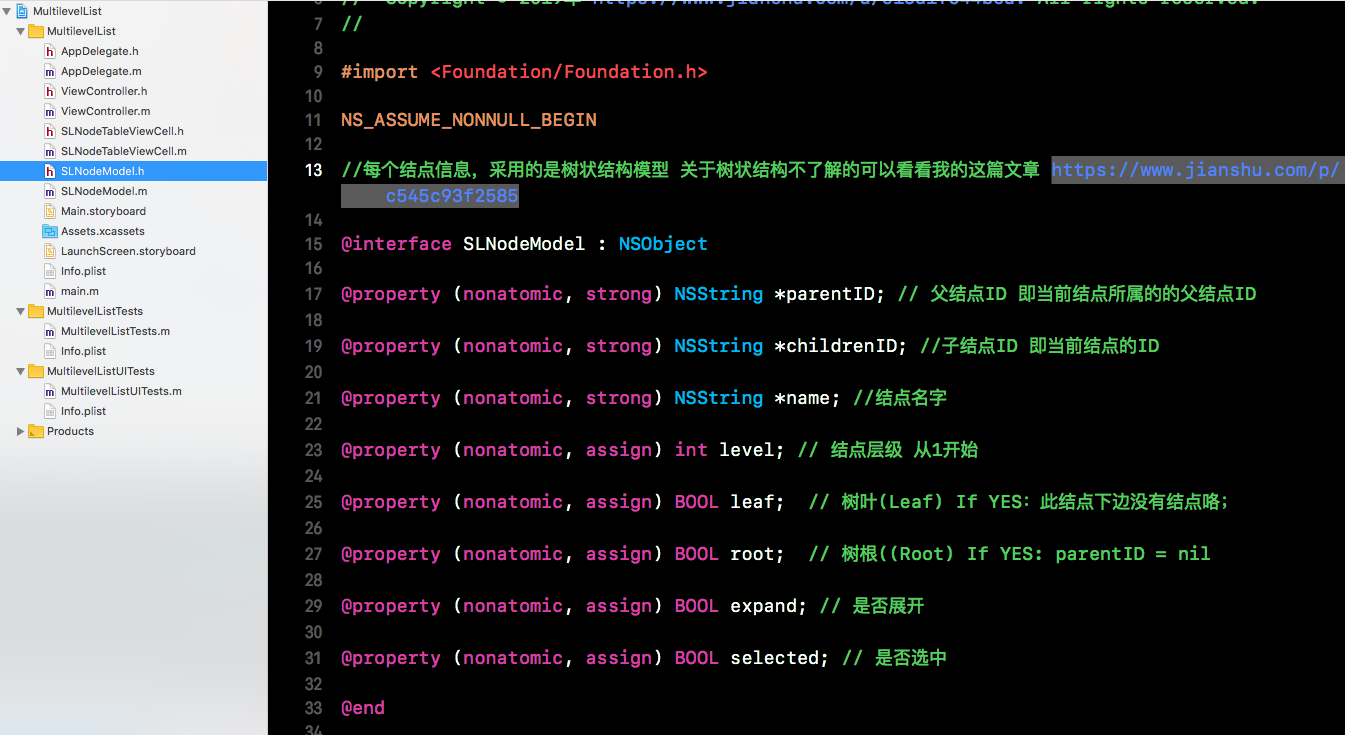效果预览

一、需求
TableView多级列表:分级展开或合并,逐级获取并展示其子级数据,可以设置最大的层级数,支持多选、单选、取消选择。
二、思路
由需求和示意图可知,这些数据元素之间存在着一对多关系,很符合 数据结构与算法 -- 树形结构 的特征。那么,我们就用树形结构中的结点(Node)来作为存储和关联数据的模型(NodeModel)。
//每个结点信息,采用的是树状结构模型
关于树状结构不了解的可以看看我的这篇文章 https://www.jianshu.com/p/c545c93f2585
@interface SLNodeModel : NSObject
@property (nonatomic, strong) NSString *parentID; // 父结点ID 即当前结点所属的的父结点ID
@property (nonatomic, strong) NSString *childrenID; //子结点ID 即当前结点的ID
@property (nonatomic, strong) NSString *name; //结点名字
@property (nonatomic, assign) int level; // 结点层级 从1开始
@property (nonatomic, assign) BOOL leaf; // 树叶(Leaf) If YES:此结点下边没有结点咯;
@property (nonatomic, assign) BOOL root; // 树根((Root) If YES: parentID = nil
@property (nonatomic, assign) BOOL expand; // 是否展开
@property (nonatomic, assign) BOOL selected; // 是否选中
@end
三、实现
层级状态: 根据传入的层级数来调整层级UI状态。
展开或合并: 通过插入或删除cell的方式来实现。(示例中的数据都是假数据,随机生成的。)
插入和删除的位置以及范围可通过点击的结点的位置、层级、子结点ID(当前结点ID)与子结点的层级或父节点相比较来确定。可以的话,做一下缓存处理,优化不分大小,从点滴做起。
/**
获取并展开父结点的子结点数组 数量随机产生
@param level 父结点的层级
@param indexPath 父结点所在的位置
*/
- (void)expandChildrenNodesLevel:(int)level atIndexPath:(NSIndexPath *)indexPath {
NSMutableArray * insertNodeRows = [NSMutableArray array];
int insertLocation = (int)indexPath.row + 1;
for (int i = 0; i < arc4random()%9; i++) {
SLNodeModel * node = [[SLNodeModel alloc] init];
node.parentID = @"";
node.childrenID = @"";
node.level = level + 1;
node.name = [NSString stringWithFormat:@"第%d级结点",node.level];
node.leaf = (node.level < MaxLevel) ? NO : YES;
node.root = NO;
node.expand = NO;
node.selected = NO;
[self.dataSource insertObject:node atIndex:insertLocation + i];
[insertNodeRows addObject:[NSIndexPath indexPathForRow:insertLocation + i inSection:0]];
}
//插入cell
[self.tableView beginUpdates];
[self.tableView insertRowsAtIndexPaths:[NSArray arrayWithArray:insertNodeRows] withRowAnimation:UITableViewRowAnimationNone];
[self.tableView endUpdates];
//更新新插入的元素之后的所有cell的cellIndexPath
NSMutableArray * reloadRows = [NSMutableArray array];
int reloadLocation = insertLocation + (int)insertNodeRows.count;
for (int i = reloadLocation; i < self.dataSource.count; i++) {
[reloadRows addObject:[NSIndexPath indexPathForRow:i inSection:0]];
}
[self.tableView reloadRowsAtIndexPaths:reloadRows withRowAnimation:UITableViewRowAnimationNone];
}
/**
获取并隐藏父结点的子结点数组
@param level 父结点的层级
@param indexPath 父结点所在的位置
*/
- (void)hiddenChildrenNodesLevel:(int)level atIndexPath:(NSIndexPath *)indexPath {
NSMutableArray * deleteNodeRows = [NSMutableArray array];
int length = 0;
int deleteLocation = (int)indexPath.row + 1;
for (int i = deleteLocation; i < self.dataSource.count; i++) {
SLNodeModel * node = self.dataSource[i];
if (node.level > level) {
[deleteNodeRows addObject:[NSIndexPath indexPathForRow:i inSection:0]];
length++;
}else{
break;
}
}
[self.dataSource removeObjectsInRange:NSMakeRange(deleteLocation, length)];
[self.tableView beginUpdates];
[self.tableView deleteRowsAtIndexPaths:deleteNodeRows withRowAnimation:UITableViewRowAnimationNone];
[self.tableView endUpdates];
//更新删除的元素之后的所有cell的cellIndexPath
NSMutableArray * reloadRows = [NSMutableArray array];
int reloadLocation = deleteLocation;
for (int i = reloadLocation; i < self.dataSource.count; i++) {
[reloadRows addObject:[NSIndexPath indexPathForRow:i inSection:0]];
}
[self.tableView reloadRowsAtIndexPaths:reloadRows withRowAnimation:UITableViewRowAnimationNone];
}
选中: 会更新当前结点下所有子结点的选中状态。
选中的位置以及范围可通过点击的结点的位置、层级、子结点ID(当前结点ID)与子结点的层级或父节点相比较来确定。可以的话,做一下缓存处理,优化不分大小,从点滴做起。
/**
更新当前结点下所有子节点的选中状态
@param level 选中的结点层级
@param selected 是否选中
@param indexPath 选中的结点位置
*/
- (void)selectedChildrenNodes:(int)level selected:(BOOL)selected atIndexPath:(NSIndexPath *)indexPath {
NSMutableArray * selectedNodeRows = [NSMutableArray array];
int deleteLocation = (int)indexPath.row + 1;
for (int i = deleteLocation; i < self.dataSource.count; i++) {
SLNodeModel * node = self.dataSource[i];
if (node.level > level) {
node.selected = selected;
[selectedNodeRows addObject:[NSIndexPath indexPathForRow:i inSection:0]];
}else{
break;
}
}
[self.tableView reloadRowsAtIndexPaths:selectedNodeRows withRowAnimation:UITableViewRowAnimationNone];
}
四、项目结构

iOS TableView多级列表
注:本文著作权归作者,由demo大师代发,拒绝转载,转载需要作者授权